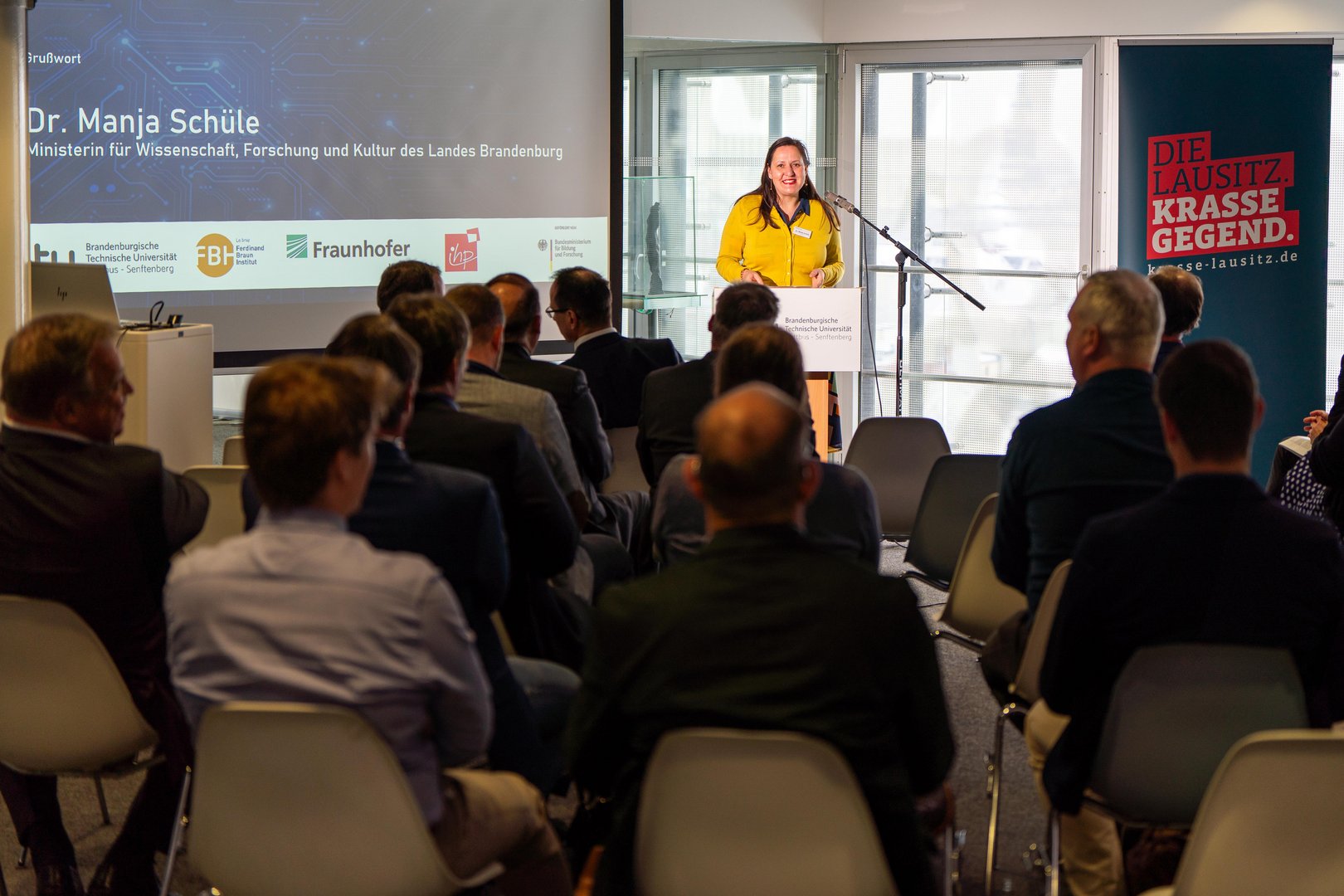Cottbus. On December 1, 2023, the project "Optoelectronic Sensors for Application-oriented Systems for Life Sciences and Intelligent Manufacturing – OASYS" celebrated its official launch at a festive kick-off event at the IKMZ of BTU Cottbus-Senftenberg. The project is being funded with 12.5 million euros by the Federal Ministry of Education and Research.
The demand for application-oriented microsensor solutions is increasing. Regional companies in particular are showing enormous interest in extending the application to the areas of industrial manufacturing, smart production, agriculture and livestock farming as well as medicine and healthcare.
In close cooperation with non-university research and development partners from the Fraunhofer-Gesellschaft, the Leibniz Association and the Carl-Thiem-Klinikum Cottbus, BTU Cottbus-Senftenberg has already built up expertise in the field of application-oriented microsensor solutions with the Electronics and Microsensor Technology Innovation Campus (iCampµs).
In the OASYS research consortium, which the Federal Ministry of Education and Research (BMBF) is funding with 12.5 million euros, the demand for innovative optosensory systems is now being translated into transfer and commercialization-oriented research. BTU Cottbus-Senftenberg is thus further expanding its research profile in the field of "Artificial Intelligence and Sensor Technology".
"With the OASYS project, we intend to close existing technological gaps in the field of MEMS-based technologies for imaging processes. Together with our industrial partners, we are developing innovative solutions that not only offer new possibilities and functionalities compared to previously available solutions, but are also compact, mobile and energy-efficient. In this way, we are not only strengthening the attractiveness of Lusatia as a location for industry and science, but also making an important contribution to strengthening European technological sovereignty. The OASYS project has technological expertise and infrastructure at its disposal that is unparalleled, even by internationalstandards," says OASYS project manager Prof. Dr. Harald Schenk, Head of the Micro and Nano Systems Department at BTU Cottbus-Senftenberg and Manager of the Fraunhofer Institute for Photonic Microsystems (IPMS).
Brandenburg's Science Minister Dr. Manja Schüle: "In the future, nothing will work without sensor solutions: Without sensors there is no data and without data there is no digitalization. Microsensors are the interface between physical reality and digital data - they are the sensory organs of digitalization and a key technology of the future. This is exactly where OASYS comes in: The research project is about smart and efficient production processes as well as intelligent manufacturing, digital medical diagnostics and medical technology. What makes it special: The research consortium pools the expertise of several scientific institutions, works together across national borders and cooperates with regional companies. The best conditions for a strong innovation ecosystem in Lusatia: the solutions and ideas developed here should help small and medium-sized companies on their way into the digital future and create more highly qualified jobs in Lusatia. There were already many good reasons to settle in Lusatia before. As of today, there is one more."
Prof. Dr. Michael Hübner, Full-time Vice President for Research and Transfer at BTU Cottbus-Senftenberg, emphasizes: "With the OASYS project, we are strengthening the "Artificial Intelligence and Sensor Technology" profile line at BTU Cottbus-Senftenberg and combining excellent research with solutions in the life sciences and intelligent manufacturing. With OASYS, we are intensifying cooperative research with Fraunhofer IPMS and the Leibniz Institutes FBH and IHP, which is exemplary for coping with structural change. In a supra-regional network of research institutions, we are making Lusatia attractive because this will create a future-oriented and innovative region."
Pooling expertise in the research consortium
By integrating the extensive expertise and infrastructure of the project partners Fraunhofer Institute for Photonic Microsystems (IPMS), Ferdinand-Braun-Institut, Leibniz-Institut für Höchstfrequenztechnik (FBH) and IHP, OASYS has access to a unique selection of technologies and materials for its research work. The ongoing consistent application and utilization orientation of the work is bundled in networks of potential users and application experts from science and industry.
"We have been actively supporting structural change in Lusatia for many years with our developments in optical sensor technology. With OASYS, we are entering the next phase in which we are developing a hyperspectral Raman imaging system that does not require complex and expensive spectrometers. This significantly simplifies measurements, for example in medical and energy technology," explains Prof. Dr. Günther Tränkle, Scientific Manager of the Ferdinand-Braun-Institut gGmbH, Leibniz-Institut für Höchstfrequenztechnik (FBH).
Prof. Dr. Gerhard Kahmen, Scientific and Technical Manager of the IHP - Leibniz-Institute for Innovations for High Performance Electronics adds: "In the OASYS project, we at the IHP, together with the IPMS, are taking up the challenge of investigating deeper tissue regions in detail. Based on our semiconductor technologies, we are able to develop and manufacturevery broadband - so-called optoacoustic - sensors. The aim is to realize innovative, compact and integrable sensors. These should enable early and precise detection of cancer, for example. Conventional diagnostic procedures for this are still often inconclusive, which is why our development work focuses on this area. Our close and successful cooperation with the BTU and the partners from the iCampus provides a very valuable basis for this."
The OASYS research consortium focuses on two thematic clusters and thus demonstrates the interdisciplinary appeal of novel sensory systems in other forward-looking fields of research:
- In the MEMS-based hyperspectral imaging cluster, research into promising sensory materials and devices is creating the basis for a wide range of innovative applications in the fields of industrial manufacturing, modern agricultural production, process technology and medical diagnostics.
- The cluster High-resolution optical processes for the life sciences addresses future needs in the fields of biology, Biotechnology, medicine, medical technology and health sciences.



